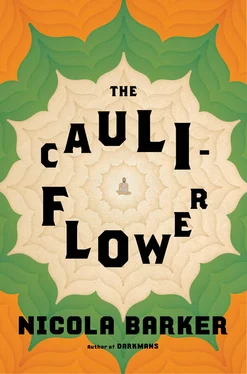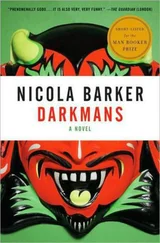God bless the Rani! Let’s throw our hats into the air— en masse .
Can we try that again, please, on the count of three (it’s the soundman’s fault — he’d nipped off for a quick smoke)? Okay, one … two …
Hair! Makeup! Repair the Rani’s chignon ! Apply some powder to that beloved chin! It’s hot down here! Deepen her blush! Redden her sweet lips! Prepare our star for her next big close-up …
Because in the not-too-distant future our beloved Rani will be slapped in the face while worshipping Ma Kali in the temple that she built herself, by a lowly — and seemingly demented — temple priest ( gasp! ).
Any ideas who? Go on. Go on. Take a guess.
Once again, we ask …
Sri Ramakrishna—
Who gave you this moniker?
What is your true name?
1878. The grandmother of a woman who will eventually become one of Sri Ramakrishna’s most devout female disciples (Yogin Ma) asks a stranger in the Dakshineswar temple garden for directions.…
Yogin Ma’s Grandmother ( having just alighted from a barge into the exquisite and fragrant temple gardens and happening across a man in a plain white wearing cloth and shiny black slippers or “scuffs” gathering armfuls of red hibiscus, whom she presumes to be a gardener ): “Excuse me, sir, I have come here to see Ramakrishna Paramahamsa . Can you please direct me to his room?”
Sri Ramakrishna ( gazing at Yogin Ma’s grandmother, blankly ): “Pardon?”
Yogin Ma’s Grandmother ( slightly irritable ): “The Paramahamsa . Ramakrishna. I have read several articles about him in the papers by the Brahmo ’s Keshab Chandra Sen. I wish to meet with him and see what I make of him.”
Sri Ramakrishna ( with contempt ): “Argh. What do I know about him? Some people call him Paramahamsa … ( shrugs ) … others call him ‘young priest,’ and still others call him Gadadhar Chatterjee ( turns away, bored ).… Please ask someone else to direct you to him.”
( Yogin Ma’s grandmother scowls, disgruntled, then goes for a stroll around the grand temple and its gardens, promptly abandoning all interest in this so-called God-man .)
In 1886, a few months before Sri Ramakrishna’s death, on being told that a famous holy man of Ghazipur has a photographic image of him hung on his wall …
( Haiku to be read in a hoarse whisper ):
Sri Ramakrishna
Points to his shrunken torso:
“Just a pillowcase!”
Twelve slightly impertinent questions about Ma Kali:
1. Why on earth is she spitting out her tongue like that?
2. She appears to be resting her foot on the chest of a prostrated, pale-skinned man. Who is he? Is he dead? Has she killed him?
3. Hang on a second — is she … is she stark naked ?
4. She looks rather tipsy! Is she drunk?
5. Is that a necklace of human skulls around her neck?
6. Is my mind playing tricks on me, or is she actually wearing some kind of — of weird skirt made out of severed human arms?
7. Is she black?
8. Why is her hair such a dreadful mess?
9. How can people love this horrible creature? Aren’t they afraid of her? Isn’t it merely a love born of fear?
10. Do people honestly worship her in cremation grounds?
11. Why is she surrounded by howling, blood-smattered jackals? Are they her familiars?
12. Is it true that Hindus actually feed their statues of Kali, and dress them up, and moisturize them, and dab them with perfume, and cool them with fans, and put them to bed in the afternoon for a quick snooze?
1857, at the Dakshineswar Kali Temple (six miles north of Calcutta)
Rotting food everywhere, Uncle says, everywhere you looked. Of course, I was not yet serving Uncle at this time, but Uncle has told me many things about the very early days of the Dakshineswar Kali Temple. There was so much food, Uncle says — spicy curries and steaming breads and delicious sweets and tempting side dishes, all prepared by the clever Brahmin cooks — but nobody wanted to come to eat it. Not at first. Not even the poor and the starving. Instead, Uncle says, the temple authorities were obliged to feed it to the sacred cows, or to the flocks of geese, or to the wild cats and dogs that scavenged within the temple walls, or to the raucous crows who filled the trees in huge flocks, or — as a final resort — to throw it into the great river Ganga for the fish and the giant eels to argue over.
All because the Rani — who had built this beautiful temple for a tremendous amount of money, Uncle says — was a Sudra , and a Sudra is not permitted to offer cooked food to the deities (only a Brahmin may perform this special service). It is a law of caste. But the Rani had built her temple and she wanted to offer cooked food there for the poor, the sadhu s, and the pilgrims to partake of.
Perhaps some people find it difficult to comprehend why it is that we Hindus offer food to our deities. Well, our faith is a humble one, and much of our religious observance takes place in our homes. Our gods are like members of our extended family, and we treat them as such — with love and with reverence. If a god visited your home, would you not water him and feed him and show him every kind of hospitality?
We Hindus like to call the food offered to our deities prasad . If it has been offered to the deities then naturally it is blessed by them — it is pure and purified — and so when we eat what they leave behind it is a holy act. (In larger temples the offered food is added — once the deities have partaken of it — to giant cauldrons of other food, and the blessings from the prasad infiltrate the whole so that many people may eat and then benefit.) Uncle tells me that Christians also enjoy prasad , but that in their faith the food is plain bread and the water is wine, and when they consume it they believe that they are eating the body and the blood of Jesus the Christ. Uncle never lies, so I must believe that this is true, no matter how much my nature rebels against it.
Long before the temple was opened, Uncle says, there was great opposition from the pandits to the idea of a Sudra —even a rich, much-respected, and devout one like the Rani — offering cooked food in a place of worship. She had been desperate to find a way to sidestep these caste rules. There had been many consultations, Uncle says. She had asked many opinions. She had sought much advice. But no respectable pandit would countenance the idea, Uncle says. Not, at least, until she happened across a Brahmin by the name of Ramkumar Chatterjee, who was then running a struggling Sanskrit school in Calcutta (and living with his young brother, Gadadhar, who was adding to their mean kitty by conducting private worship in people’s homes). Ramkumar responded to a letter that the Rani had sent him by saying that according to his understanding of the scriptures he saw no good reason why the Rani might not offer cooked food in her new temple so long as she made a formal gift of the temple property to a Brahmin and allowed him to oversee the installation of the deities and the cooking of the food to be offered therewithin.
The Rani was ecstatic, Uncle says, when she received his advice and so proceeded accordingly. The temple was formally signed over to her family guru and when it was opened she invited the Brahmin whose advice had been so helpful to her to officiate over the installation of the image of Kali and to stay on as a priest until another could be found.
Unlike his older brother, Uncle was very contented with his life working as a household priest in Calcutta. His employers were always charmed by his intense devotion and made a great fuss of him, Uncle says. They gave him free rein. Some priests will just go through the motions, but definitely not Uncle. Uncle’s love of God spills from his every pore and flows through his every vein. And he sings so sweetly, and dances so beautifully. He is so handsome and so innocent. Who can fail but to be bewitched by him?
Читать дальше












